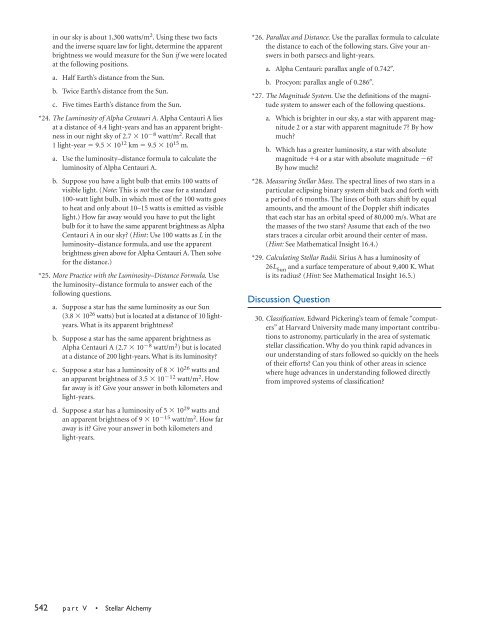Chapter 16--Properties of Stars
Chapter 16--Properties of Stars
Chapter 16--Properties of Stars
Create successful ePaper yourself
Turn your PDF publications into a flip-book with our unique Google optimized e-Paper software.
in our sky is about 1,300 watts/m2 .Using these two facts<br />
and the inverse square law for light, determine the apparent<br />
brightness we would measure for the Sun if we were located<br />
at the following positions.<br />
a. Half Earth’s distance from the Sun.<br />
b. Twice Earth’s distance from the Sun.<br />
c. Five times Earth’s distance from the Sun.<br />
*24. The Luminosity <strong>of</strong> Alpha Centauri A. Alpha Centauri A lies<br />
at a distance <strong>of</strong> 4.4 light-years and has an apparent brightness<br />
in our night sky <strong>of</strong> 2.7 108 watt/m2 .Recall that<br />
1 light-year 9.5 1012 km 9.5 1015 m.<br />
a. Use the luminosity–distance formula to calculate the<br />
luminosity <strong>of</strong> Alpha Centauri A.<br />
b. Suppose you have a light bulb that emits 100 watts <strong>of</strong><br />
visible light. (Note: This is not the case for a standard<br />
100-watt light bulb, in which most <strong>of</strong> the 100 watts goes<br />
to heat and only about 10–15 watts is emitted as visible<br />
light.) How far away would you have to put the light<br />
bulb for it to have the same apparent brightness as Alpha<br />
Centauri A in our sky? (Hint: Use 100 watts as L in the<br />
luminosity–distance formula, and use the apparent<br />
brightness given above for Alpha Centauri A. Then solve<br />
for the distance.)<br />
*25. More Practice with the Luminosity–Distance Formula. Use<br />
the luminosity–distance formula to answer each <strong>of</strong> the<br />
following questions.<br />
a. Suppose a star has the same luminosity as our Sun<br />
(3.8 1026 watts) but is located at a distance <strong>of</strong> 10 lightyears.<br />
What is its apparent brightness?<br />
b. Suppose a star has the same apparent brightness as<br />
Alpha Centauri A (2.7 10 8 watt/m 2 ) but is located<br />
at a distance <strong>of</strong> 200 light-years. What is its luminosity?<br />
c. Suppose a star has a luminosity <strong>of</strong> 8 10 26 watts and<br />
an apparent brightness <strong>of</strong> 3.5 10 12 watt/m 2 .How<br />
far away is it? Give your answer in both kilometers and<br />
light-years.<br />
d. Suppose a star has a luminosity <strong>of</strong> 5 10 29 watts and<br />
an apparent brightness <strong>of</strong> 9 10 15 watt/m 2 .How far<br />
away is it? Give your answer in both kilometers and<br />
light-years.<br />
542 part V • Stellar Alchemy<br />
*26. Parallax and Distance. Use the parallax formula to calculate<br />
the distance to each <strong>of</strong> the following stars. Give your answers<br />
in both parsecs and light-years.<br />
a. Alpha Centauri: parallax angle <strong>of</strong> 0.742.<br />
b. Procyon: parallax angle <strong>of</strong> 0.286.<br />
*27. The Magnitude System. Use the definitions <strong>of</strong> the magnitude<br />
system to answer each <strong>of</strong> the following questions.<br />
a. Which is brighter in our sky, a star with apparent magnitude<br />
2 or a star with apparent magnitude 7? By how<br />
much?<br />
b. Which has a greater luminosity, a star with absolute<br />
magnitude 4 or a star with absolute magnitude 6?<br />
By how much?<br />
*28. Measuring Stellar Mass. The spectral lines <strong>of</strong> two stars in a<br />
particular eclipsing binary system shift back and forth with<br />
a period <strong>of</strong> 6 months. The lines <strong>of</strong> both stars shift by equal<br />
amounts, and the amount <strong>of</strong> the Doppler shift indicates<br />
that each star has an orbital speed <strong>of</strong> 80,000 m/s. What are<br />
the masses <strong>of</strong> the two stars? Assume that each <strong>of</strong> the two<br />
stars traces a circular orbit around their center <strong>of</strong> mass.<br />
(Hint: See Mathematical Insight <strong>16</strong>.4.)<br />
*29. Calculating Stellar Radii. Sirius A has a luminosity <strong>of</strong><br />
26L Sun and a surface temperature <strong>of</strong> about 9,400 K. What<br />
is its radius? (Hint: See Mathematical Insight <strong>16</strong>.5.)<br />
Discussion Question<br />
30. Classification. Edward Pickering’s team <strong>of</strong> female “computers”<br />
at Harvard University made many important contributions<br />
to astronomy, particularly in the area <strong>of</strong> systematic<br />
stellar classification. Why do you think rapid advances in<br />
our understanding <strong>of</strong> stars followed so quickly on the heels<br />
<strong>of</strong> their efforts? Can you think <strong>of</strong> other areas in science<br />
where huge advances in understanding followed directly<br />
from improved systems <strong>of</strong> classification?
















